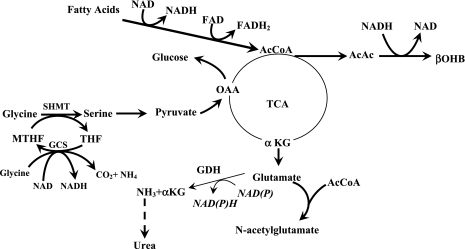Fig. 5.
Effect of fatty acids on hepatic ureagenesis and glycine cleavage system in NASH; greater β-oxidation of fatty acids in response to increased fatty acid uptake results in decreased NAD:NADH ratio and increased generation of reactive oxygen species, consequently attenuating tricarboxylic acid cycle flux and higher β-hydroxybutyrate (βOHB) synthesis. The lower rate of ureagenesis in response to hepatic fatty acid oxidation may be the result of change in redox and its effect on glutamate dehydrogenase (GDH), resulting in lower production of ammonia (detailed in discussion). The greater utilization of serine for gluconeogenesis induced by fatty acid oxidation and for cystathionine synthesis will result in lower Ra of glycine. Interestingly, the change in redox in the mitochondrial matrix did not impact the GCS. AcAc, acetoacetate; αKG, α-ketoglutarate; MTHF, methylene tetrahydrofolate; OAA, oxaloacetic acid; TCA, tricarboxylic acid cycle; AcCoA, acetyl CoA.

